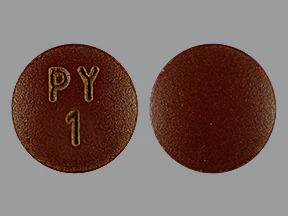Why is this medication prescribed?
In addition to reducing urgent and frequent urination brought on by urinary tract infections, surgery, injury, or examination procedures, phenazopyridine also soothes pain, burning, irritation, and discomfort in the urinary system. Phenazopyridine, however, is not an antibiotic and does not treat infections.
How should this medicine be used?
To be used orally, phenazopyridine is available as a tablet or capsule. After meals, it is often taken three times daily. Avoid crushing or chewing the pills since it could discolour your teeth; instead, consume them whole with a full glass of water. When all pain and discomfort are gone, you may stop using this medication. Ask your doctor or pharmacist to explain any instructions on your prescription label that you are unsure about following. Follow the phenazopyridine directions precisely. Never take it in larger or smaller amounts or more frequently than directed by your doctor.
Other uses for this medicine
Ask your doctor or pharmacist for more details if you’re interested in using this drug for any other conditions.
What special precautions should I follow?
Before taking phenazopyridine,
- If you have an allergy to phenazopyridine or any other medication, tell your doctor and pharmacist.
- In addition to vitamins, be sure to let your doctor and pharmacist know what prescription and over-the-counter medications you are taking.
- Inform your doctor if you have kidney disease or a lack of glucose-6-phosphate dehydrogenase (G-6-PD).
- Inform your doctor if you are expecting, intend to get pregnant, or are nursing a baby. Call your doctor if you become pregnant while taking phenazopyridine.
What should I do if I forget a dose?
If you miss a dose, take it as soon as you remember. If the next dose is soon due, skip the missed one and carry on with your regular dosing plan. To make up for a missed dose, do not take a second one.
What side effects can this medication cause?
Side effects from phenazopyridine are possible. It’s harmless if your pee takes on a reddish-orange or brown hue. If any of these symptoms are severe or do not go away, let your doctor know right once:
- Headache
- Dizziness
- Uneasy stomach
Call your doctor right away if you experience any of the following symptoms:
- The skin or eyes turning yellow
- Fever
- Confusion
- Colour of the skin (blue to bluish-purple)
- Shortness of breath
- Skin rash
- Sudden reduction in urine production
- Swelling of the fingers, feet, legs, or face
You or your doctor can submit a report to the Food and Drug Administration’s (FDA) MedWatch Adverse Event Reporting programme online or by phone if you experience a serious side effect.
What should I know about storage and disposal of this medication?
Keep this medication tightly closed in the original container and out of the reach of children. Store it away from excessive heat and moisture at room temperature.
Unused prescriptions must be disposed of carefully to prevent pets, kids, and other people from ingesting them. You should not, however, dispose of this medication in the toilet. Instead, utilising a medicine take-back programme is the easiest approach to get rid of your medication. To find out about take-back programmes in your area, speak with your pharmacist or the garbage/recycling department in your city. If you do not have access to a take-back programme, see the FDA’s Safe Disposal of Medicines website at http://goo.gl/c4Rm4p for additional information.
As many containers (such as weekly pill minders and those for eye drops, creams, patches, and inhalers) are not child-resistant and are simple for young children to open, it is crucial to keep all medications out of sight and out of reach of children. Always lock safety caps and promptly stash medication up and away from young children where it is out of their sight and reach to prevent poisoning. http://www.upandaway.org
In case of emergency/overdose
Call the poison control hotline at 1-800-222-1222 in the event of an overdose. Additionally, information can be found online at https://www.poisonhelp.org/help. Call 911 right away if the victim has collapsed, experienced a seizure, is having difficulty breathing, or cannot be roused.
What other information should I know?
Keep all of your appointments with your physician and the lab. To determine how you are reacting to phenazopyridine, your doctor will request specific lab tests.
Laboratory tests, such as urine tests for glucose (sugar) and ketones, can be affected by phenazopyridine. If you have diabetes, you should test your urine for sugar with Clinitest rather than Tes-Tape or Clinistix. The Ketostix and Acetest urine tests for ketones may produce inaccurate findings. Inform the lab staff and doctor that you are taking this medicine prior to any testing.
Contact lenses and garments are stained by phenazopyridine. While using this medication, refrain from wearing contact lenses.
No one else should take your medication. It’s likely that your prescription cannot be renewed.
Call your doctor if you continue to experience symptoms after taking the phenazopyridine.
You should keep a written record of every medication you take, including any over-the-counter (OTC) items, prescription drugs, and dietary supplements like vitamins and minerals. This list should be brought with you whenever you see a doctor or are admitted to the hospital. You should always have this information with you in case of emergencies.
Brand names
- Azo-Standard®
- Baridium®
- Nefrecil®
- Phenazodine®
- Prodium®
- Pyridate®
- Pyridium®
- Sedural®
- Uricalm®
- Uristat®
- Uropyrine®
- Urodine®
- Urogesic®


